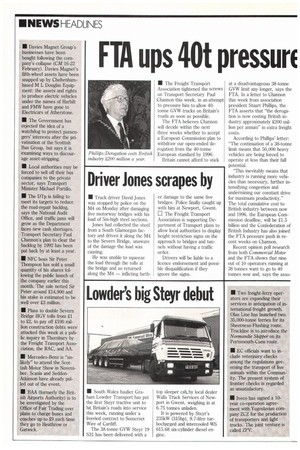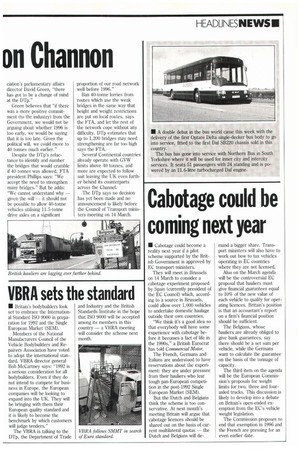FTA ups 40t pressor( on Channon
Page 6

Page 7

If you've noticed an error in this article please click here to report it so we can fix it.
• The Freight Transport Association tightened the screws on Transport Secretary Paul Channon this week, in an attempt to pressure him to allow 40tonne GVW trucks on Britain's roads as soon as possible.
The FTA believes Channon will decide within the next three weeks whether to accept a European Commission plan to withdraw our open-ended derogation from the 40-tonne European standard by 1996.
Britain cannot afford to stick at a disadvantageous 38-tonne GVW limit any longer, says the FTA. In a letter to Channon this week from association president Stuart Phillips, the FTA asserts that "the derogation is now costing British industry approximately 2200 million per annum" in extra freight costs.
According to Phillips' letter: —Ile continuation of a 38-tonne limit means that 50,000 heavy vehicles are being forced to operate at less than their full potential.
"This inevitably means that industry is running more vehicles than necessary, further intensifying congestion and undermining our constant drive for maximum productivity." The total cumulative cost to British industry between now and 1996, the European Commission deadline, will be 21.5 billion and the Confederation of British Industry has also joined the FTA pressure push in recent weeks on Channon.
Recent opinion poll research from both Commercial Motor and the EFTA shows that nine out of 10 operators running at 38 tonnes want to go to 40 tonnes now and, says the asso ciation's parliamentary affairs director David Green, "there has got to be a change of mind at the DTp."
Green believes that "if there was a more positive commitment (to the industry) from the Government, we would not be arguing about whether 1996 is too early, we would be saying that it is too late. Given the political will, we could move to 40 tonnes much earlier."
Despite the DTp's reluctance to identify and number the bridges that would crumble if 40 tonnes was allowed, FTA president Phillips says: "We accept the need to strengthen many bridges." But he adds: "We cannot understand why — given the will — it should not be possible to allow 40-tonne vehicles utilising 11.5-tonne drive axles on a significant proportion of our road network well before 1996."
Ban 40-tonne lorries from routes which use the weak bridges in the same way that height and weight restrictions are put on local routes, says the 1.7A, and let the rest of the network cope without any difficulty. DTp estimates that up to 1,200 bridges may need strengthening are far too high says the ETA.
Several Continental countries already operate with GVW limits above 40 tonnes, and more are expected to follow suit leaving the UK even further behind its counterparts across the Channel.
The DTp says no decision has yet been made and no announcement is likely before the Council of Transport ministers meeting on 14 March.
















































































































































